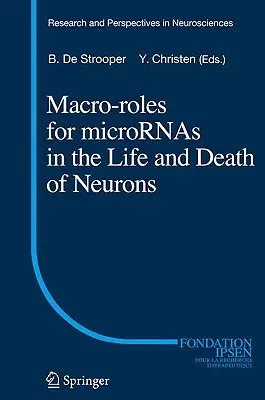ThediscoveryofmicroRNAshasrevealedanunexpectedandspectacularadditional
levelof?netuningofthegenomeandhowgenesareusedagainandagainin
differentcombinationstogeneratethecomplexitythatunderliesforinstancethe
brain. SincetheinitialstudiesperformedinC. elegans, wegavegoneafarwayto
begintounderstandhowmicroRNApathwayscanhaveanimpactonhealthand
diseaseinhuman. AlthoughmicroRNAsareabundantlyexpressedinthebrain,
relativelylittleisknownaboutthemultiplefunctionsoftheseRNAmoleculesinthe
nervous system. Nevertheless, we knowalready that microRNA pathways play
majorrolesintheproliferation, differentiation,
functionandmaintenanceofneu- nalcells.
SeveralintriguingstudieshavelinkedmicroRNAsasmajorregulatorsof
theneuronalphenotype, andhaveimplicatedspeci?cmicroRNAsintheregulation
ofsynapseformationandplasticity. DysfunctionofmicroRNApathwaysisalso
slowlyemergingasapotentialimportantcontributortothepathogenesisofmajor
neurodegenerativedisorderssuchasAlzheimer'sdiseaseandParkinson'sdisease.
Thesenovelinsightsappeartobeparticularpromisingfortheunderstandingofthe
veryfrequentandbadlyunderstoodsporadicformsofthesediseasesascomparedto
thegeneticforms. Thus,
thebetterunderstandingoftheimplicationsofthisnovel
?eldofmolecularbiologyiscrucialforthebroadareaofneurosciences, fromthe
fundamentalaspectstotheclinic, andfromnoveldiagnostictopotentiallythe-
peuticapplicationsforsevereneurologicalandmaybepsychiatricdiseases. The
presentvolumegatherscontributionstotheColloqueMe´decineetRechercheonthe
implicationsofmicroRNAsinneuroscienceorganizedbytheFondationIpsen, in
Paris, onApril20,2009.
Ithadasobjectivetobringtogetherneuroscientistsfrom
differentareasofresearchtodiscusstheircurrentinsightsintothewonderfulworld
ofmicroRNAs, andtohearanddiscusstheirresearchandviewsaboutmicroRNA
biologyinneuronalprocessesandinbraindisorders. BartdeStrooper
YvesChristen v Acknowledgments The editors wish to thank Jacqueline
Mervaillie and Sonia Le Cornec for the
organizationofthemeetingandMaryLynnGagefortheeditingofthebook. vii
Contents Pro?lingthemicroRNAs . . . . . . . . . . . . . . . . . . . . .
. . . . . . . . . . . . . . . . . . . . . . . . . . . . . . . . . 1
KennethS. Kosik, ThalesPapagiannakopoulos, NaXu, KawtherAbu-Elneel,
TsunglinLiu, andMinJeongKye TheWideVarietyofmiRNAExpressionPro?les
intheDevelopingandMatureCNS . . . . . . . . . . . . . . . . . . . . . .
. . . . . . . . . . . . . . . . . . . . 9 MarikaKapsimali
InteractionsbetweenmicroRNAsandTranscription
FactorsintheDevelopmentandFunction oftheNervousSystem . . . . . . . . .
. . . . . . . . . . . . . . . . . . . . . . . . . . . . . . . . . . . .
. . . . . . . . . . . 19 DavidJ. Simon
AmicroRNAFeedbackCircuitinMidbrainDopamineNeurons . . . . . . . . . 27
AsaAbeliovich Fine-tuningmRNATranslationatSynapseswithmicroRNAs . . . .
. . . . . . . . 35 GerhardM. Schratt
NeuronalP-bodiesandTransportofmicroRNA-Repressed mRNAs . . . . . . . . .
. . . . . . . . . . . . . . . . . . . . . . . . . . . . . . . . . . . .
. . . . . . . . . . . . . . . . . . . . . . . . . . . . 45 FlorenceRage
CrosstalkbetweenmicroRNAandEpigeneticRegulation inStemCells . . . . . .
. . . . . . . . . . . . . . . . . . . . . . . . . . . . . . . . . . . .
. . . . . . . . . . . . . . . . . . . . . . . . . 57 KeithSzulwach,
ShuangChang, andPengJin microRNAsinCNSDevelopmentandNeurodegeneration:
InsightsfromDrosophilaGenetics . . . . . . . . . . . . . . . . . . . . .
. . . . . . . . . . . . . . . . . . . . . . 69 StephenM. Cohen ix x
Contents DrosophilaasaModelforNeurodegenerativeDisease:
RolesofRNAPathwaysinPathogenesis . . . . . . .

